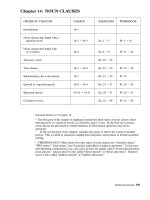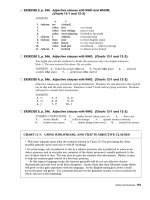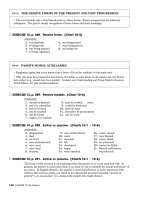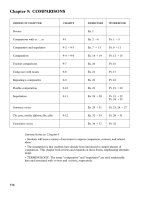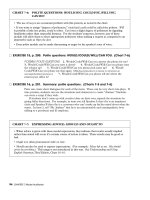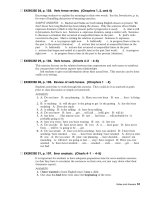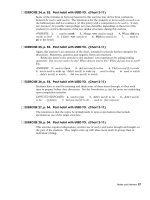TRANSITIVITY ANALYSIS OF THE ENGLISH VERSION OF a HANOI TRAVEL GUIDE = PHÂN TÍCH hệ THỐNG CHUYỂN tác TRONG CUỐN GIỚI THIỆU DU LỊCH về hà nội
Bạn đang xem bản rút gọn của tài liệu. Xem và tải ngay bản đầy đủ của tài liệu tại đây (27.52 MB, 161 trang )
VIETNAM NATIONAL UNIVERSITY, HANOI
UNIVERSITY OF LANGUAGES AND INTERNATIONAL STUDIES
FACULTY OF LINGUISTICS & CULTURE OF ENGLISH-SPEAKING COUNTRIES
GRADUATION PAPER
TRANSITIVITY ANALYSIS OF THE ENGLISH
VERSION OF A HANOI TRAVEL GUIDE
Supervisor: Nguyễn Thị Minh Tâm (Ph.D.)
Student: Lê Hiền Anh
Course: QH2017.F1.E2
HÀ NỘI – 2021
ĐẠI HỌC QUỐC GIA HÀ NỘI
TRƯỜNG ĐẠI HỌC NGOẠI NGỮ
KHOA NGƠN NGỮ VÀ VĂN HỐ CÁC NƯỚC NĨI TIẾNG ANH
KHỐ LUẬN TỐT NGHIỆP
PHÂN TÍCH HỆ THỐNG CHUYỂN TÁC TRONG
CUỐN GIỚI THIỆU DU LỊCH VỀ HÀ NỘI
Giáo viên hướng dẫn: TS. Nguyễn Thị Minh Tâm
Sinh viên: Lê Hiền Anh
Khoá: QH2017.F1.E2
HÀ NỘI – 2021
I hereby state that I: Le Hien Anh, class QH2017.F1.E2, being a candidate for
the degree of Bachelor of Arts (B.A. Honours Programme) accept the requirements of
the College relating to the retention and use of Bachelor’s Graduation Paper deposited
in the library.
In terms of these conditions, I agree that the origin of my paper deposited in the
library should be accessible for the purposes of study and research, in accordance with
the normal conditions established by the librarian for the care, loan or reproduction of
the paper.
Signature
Hanoi, May 4th, 2021.
ACKNOWLEDGEMENTS
First and foremost, I would like to express my sincere gratitude to my beloved
supervisor, Ms. Nguyen Thi Minh Tam (Ph.D.). She is the true definition of an angel
who was sent to save me when I was losing my way. Thank you so much for your
constructive feedback and helpful guidance from the very beginning until the end of this
journey. It was your devotion that encouraged me to bravely start my thesis all over
again from scratch.
I also wish to thank all of my friends for their support and enthusiasm. To
Nguyên, Bạch, and Linh from 17E2, you three are the best groupmates that I can ask
for. I will always remember our sleepless nights before the deadlines, insane small talks
during break time, and messenger calls to urge each other to work. I am glad that even
though the thesis was individual work, we still stuck together through thick and thin.
Additionally, I very much appreciate the assistance from Thu Huyền, my best friend.
You always showed up whenever I needed your help, from staying up late at night to
keep me company to waking me up with morning phone calls so that I could continue
with the work. Had it not been for your support, it would have been impossible for me
to complete everything by myself.
Furthermore, I am sending my deepest appreciation to my family. To my mother,
the most delicate woman who fully understood my situation and supported me
unconditionally. To my father, who is not here with us anymore, but still is a great source
of encouragement and strength. It is heartbreaking that he cannot witness this moment
with his own eyes, however, I believe that on the other side, he is always watching and
advocating for me.
Last but not least, special thanks go to my Korean idols group Highlight. It was
their energetic, cheerful music that kept me awake to finish my paper, and it was their
positive attitude in life that motivated me to persistently follow this path.
i
ABSTRACT
Travel brochure is one of the most effective ways to promote a destination, yet it
does not receive enough attention compared to other tourism products (Quinn, 1982).
Acknowledging its significant position in tourism field, the researcher aims at
examining the Transitivity system of a Hanoi travel guide to gain deeper understanding
about its contents. Through the use of Systemic Functional Linguistics framework and
the support of Multimodal Discourse Analysis framework, the data was analyzed, and
the results revealed that Relational Process is the most frequently used, followed by
Material Process, Mental Process, Existential Process, Behavioral Process, and Verbal
Process respectively. Careful investigation also showed that five different representative
subjects have been represented linguistically and visually through the Transitivity
system of the travel guide. Last but not least, the application of language to convey
essential message is noted to be more than that of images. In this brochure, the photos
are only employed to support the meaning of written texts. Further studies into this topic
are suggested to widen the corpus, take other linguistic and visual aspects into
consideration, and generalize the findings.
Keywords: SFL theory, Transitivity system, Travel brochure
ii
TABLE OF CONTENTS
PAGE
ACKNOWLEDGEMENTS ..........................................................................................i
ABSTRACT ..................................................................................................................ii
LIST OF TABLES, FIGURES, AND ABBREVIATIONS, ETC. …………………vi
INTRODUCTION ........................................................................................................1
1. Rationale of the study .............................................................................................1
2. Aims and research questions ..................................................................................2
3. Scope of the study ..................................................................................................2
4. Methods of the study ..............................................................................................3
5. Significance of the study ........................................................................................3
6. Structure of the study .............................................................................................3
CHAPTER 1:
THEORETICAL BACKGROUND AND LITERATURE REVIEW …...………...5
1.1. Systemic Functional Linguistics (SFL) ...............................................................5
1.1.1. The notion of text in SFL ............................................................................5
1.1.2. Three lines of meaning in texts ...................................................................6
1.1.3. Ideational meaning .....................................................................................7
1.2. Transitivity ......................................................................................................... 8
1.2.1. Process .......................................................................................................9
1.2.1.1. Material Process ................................................................................9
1.2.1.2. Mental Process .................................................................................10
1.2.1.3. Relational Process ............................................................................11
1.2.1.4. Verbal Process .................................................................................12
1.2.1.5. Behavioral Process .......................................................................... 13
1.2.1.6. Existential Process ...........................................................................13
1.2.2. Participants ...............................................................................................14
1.2.3. Circumstances ..........................................................................................15
iii
1.3. Multimodal Discourse Analysis (MDA) ...........................................................16
1.3.1. Michael O’Toole’s approach ....................................................................17
1.3.2. Gunther Kress and Theo van Leeuwen’s approach ……………………...17
1.3.2.1. Action Process .................................................................................19
1.3.2.2. Reaction Process ..............................................................................19
1.3.2.3. Speech Process ................................................................................19
1.3.2.4. Mental Process .................................................................................20
1.3.2.5. Classification Process ......................................................................21
1.3.2.6. Analytical Process and Symbolic Process ........................................21
1.4. Travel brochure as a sub-genre of advertisement ..............................................23
1.5. Related studies ..................................................................................................26
CHAPTER 2: RESEARCH METHODOLOGY ......................................................30
2.1. Description of data ............................................................................................30
2.2. Data collection instruments ...............................................................................31
2.3. Data analysis .....................................................................................................31
2.3.1. Methods of the study ................................................................................31
2.3.2. Analytical framework ...............................................................................32
2.3.3. Data analysis procedure ............................................................................34
CHAPTER 3: FINDINGS AND DISCUSSION ........................................................36
3.1. Baseline information .........................................................................................36
3.2. Findings ............................................................................................................46
3.2.1. Hanoi city .................................................................................................46
3.2.2. Tourism places .........................................................................................50
3.2.3. Foods ........................................................................................................53
3.2.4. Travellers .................................................................................................55
3.2.5. Hanoians ..................................................................................................57
3.3. Discussion ........................................................................................................ 58
iv
3.3.1. Answering sub-question 1 ........................................................................58
3.3.2. Answering sub-question 2 ........................................................................62
3.3.3. Answering the overarching question ........................................................64
CONCLUSION............................................................................................................65
1. Summary of key ideas ..........................................................................................65
2. Implications .........................................................................................................66
3. Limitations and Suggestions for Further Studies ..................................................66
REFERENCES ........................................................................................................... 68
APPENDIX A. HANOI TRAVEL GUIDE ...............................................................75
APPENDIX B. LINGUISTIC ASPECT ....................................................................81
APPENDIX C. VISUAL ASPECT ...........................................................................148
v
LIST OF TABLE, FIGURES, AND ABBREVIATIONS, ETC.
Figure 1.1: The three metafunctions of language
(Halliday & Matthiessen, 2014, p.31) .............................................................................7
Figure 1.2: Six types of Process
(Halliday & Matthiessen, 2014, p.216) ...........................................................................9
Figure 1.3: Relational Process .......................................................................................11
Figure 1.4: A panel from comic books “Haikyu!!” (Furudate, 2012) ............................19
Figure 1.5: Example of Behavioral Process ...................................................................19
Figure 1.6: A panel from comic books “Haikyu!!” (Furudate, 2012)
with Verbal Process .......................................................................................................20
Figure 1.7: A panel from comic books “Haikyu!!” (Furudate, 2012)
with Mental Process ......................................................................................................20
Figure 1.8: Example of Existential Process ...................................................................21
Figure 1.9: Example of Relational Process ....................................................................22
Table 1: The roles of Participants in the clause ..............................................................14
Table 2: Types of Circumstances ..................................................................................16
Figure 1. Distribution of Processes in Introduction section ...........................................38
Figure 2. Distribution of Circumstances in Introduction section ...................................38
Figure 3. Distribution of Processes in Sightseeing section ............................................40
Figure 4. Distribution of Circumstances in Sightseeing section ....................................40
Figure 5. Distribution of Processes in Foods section .....................................................42
Figure 6. Distribution of Circumstances in Foods section .............................................42
Figure 7. Distribution of Processes in the Brochure .......................................................44
Figure 8. Distribution of Circumstances in the Brochure ...............................................45
Table 3. The number of clauses in the brochure .............................................................36
vi
Table 4. Distribution of Processes in Introduction section .............................................37
Table 5. Distribution of Processes in Sightseeing section ..............................................39
Table 6. Distribution of Processes in Foods section .......................................................41
Table 7. Distribution of Processes in the Brochure ........................................................43
Table 8. Distribution of Circumstances in the Brochure ................................................44
Figure 9. Image of Hanoi city ........................................................................................49
Figure 10. Map of Hanoi city .........................................................................................50
Figure 11. Image of tourism places in Hanoi city ..........................................................53
Figure 19. Xôi xéo .........................................................................................................55
Figure 24. Travellers .....................................................................................................57
Figure 25. Hanoians ......................................................................................................58
SFL: Systemic Functional Linguistics
MDA: Multimodal Discourse Analysis
vii
INTRODUCTION
1. Rationale of the study
Many countries, including Vietnam, are focusing on making tourism a fastgrowing economic sector in the economic structure because of the benefits that this nonsmoke industry brings1. In order to achieve this goal, a wide range of means were applied
to exploit and maximize the potential beauty of Vietnam such as forming new
advertising websites, writing articles for famous magazines, and indispensably,
designing travel brochures. At first glance, designing a travel brochure may not be
something that is worth the time and attention, which explains why it is so poorly written
to the point that it drives potential customers away (Quinn, 1982). However, with a welldesigned travel brochure, a place can indeed attract more customers and increase
business because they probably know the place from their friends or colleagues but still
choose to get the information from the brochure before making a decision. Furthermore,
the utilization of both linguistic and visual aspects in advertisements is an interesting
area of research, yet this area receives little attention from both the linguists and the
managers of travel agencies which results in the lack of previous studies related to the
topic (Banyai & Glover, 2012). Besides, among many types of advertisements, brochure
is selected due to the fact that the writer has already had some experiences working with
this kind of documents in the past and found it appropriate to use as the key data in her
thesis.
Understanding the significant role of travel brochures in the field of tourism, the
researcher intends to utilize the Systemic Functional Linguistics framework (hereafter
SFL) with the assistance of Multimodal Discourse Analysis framework (hereafter
MDA), which is SFL-based as it originated and developed from SFL theories, to
investigate how Ideational meaning, or to be more specific, Transitivity system is
applied through linguistic aspect and visual aspect in a Hanoi travel guide. It should be
1
“Phát triển du lịch trở thành ngành mũi nhọn; du lịch chiếm tỷ trọng ngày càng cao trong cơ cấu GDP, tạo động
lực thúc đẩy phát triển kinh tế - xã hội” (Thủ tướng chính phủ, 2011, p.1).
1
noted that Ideational meaning, one of three metafunctions of language, is realized
through the system of Transitivity. In other words, exploration of the Transitivity system
of a travel brochure can reveal what ideas or experiences about the world that the
author(s) of the brochure could bring to the audience. The exploration of the Transitivity
system is very much the same as the exploration of how language and visuals are used
to express content and exchange information (Abbas & Talaat, 2019). Therefore, the
researcher decided to focus on Transitivity analysis with the hope to uncover the main
purposes of language and images used inside a brochure.
In short, all of the above conditions allow the researcher to carry out a study
entitled “Transitivity analysis of the English version of a Hanoi travel guide”.
2. Aims and research questions
This paper aims at exploring the contents of a Hanoi travel guide through
analyzing the Transitivity system of it. With this aim, an overarching research question
is formulated as follows:
What is represented through the transitivity system of the English version of a Hanoi
travel guide?
In order to seek the answer to this overarching question, the researcher tried to answer
the two sub-questions as follows:
1. What is represented linguistically through the transitivity system of the
English version of a Hanoi travel guide?
2. What is represented visually through the transitivity system of the English
version of a Hanoi travel guide?
3. Scope of the study
A 14-page English version of a Hanoi travel guide posted in 2016 on an online
website named Vietnam Online is used as the target data in this research. Through SFLbased discourse analysis, the Transitivity system is investigated thoroughly to see what
is represented linguistically and visually in the travel brochure, or in other words, what
2
ideas or experience would the readers have when reading this brochure. It should also
be noticed that the system of Transitivity representing Experiential meaning is one of
the two aspects of Ideational metafunction. The other aspect namely logical function
will not be discussed in this paper.
4. Methods of the study
Due to the fact that only one travel brochure is inspected, it is believed that this
study is a case study, taking qualitative approach as the main research methodology,
with some of quantitative techniques, to explore the case of the English version of a
travel brochure of Hanoi. With regards to the analysis procedure, the data was divided
into two types, linguistic data – the language, and visual data – the images. The
analytical framework for qualitative analysis is going to be Hallidayan SFL, with some
contribution from MDA for the exploration of the visual elements.
5. Significance of the study
This research aims at analyzing the Transitivity system in the English version of
a Hanoi travel brochure to explore its contents. The research outcomes are believed to
contribute to the existing body of knowledge related to the field. Linguists and
researchers can also take full advantages of such results as reference for their further
research works. As for managers of travel agencies, gaining knowledge in this academic
area would assist them in recognizing the attributes of good travel brochures and the
advantages of applying transitivity in designing good ones. Last but not least, teachers
and educators can make use of this study in the sense that they realise the importance of
designing teaching materials in general and using illustrations in classrooms in particular
to improve the teaching-learning process.
6. Structure of the study
The study is divided into five sections as follows:
Introduction specifies clearly the rationale of the study together with its research
questions, research aims, significance, and scope.
3
Chapter 1: Theoretical Background and Literature Review provides an overview of
the related concepts emerging in the research along with previous studies in the field.
Chapter 2: Research methodology clarifies appropriate research methods, analytical
framework, data collection instruments, and data analysis procedure.
Chapter 3: Findings and Discussion presents and discusses the results in an attempt to
answer one overarching research question and two sub-questions raised above.
Conclusion summarizes the main outcomes of this paper as well as highlights its
limitations and proposes some suggestions for further studies.
4
CHAPTER 1: THEORETICAL BACKGROUND
AND LITERATURE REVIEW
1.1. Systemic Functional Linguistics (SFL)
Systemic Functional Linguistics (SFL), also known as Hallidayan linguistics or
systemic linguistics, is “the study of the relationship between language and its functions
in social settings” which was developed and first introduced by Michael Alexander
Kirkwood Halliday in an article named “Categories of the theory of grammar” during
the 1960s (Halliday & Matthiessen, 2013; Abbas & Talaat, 2019; Nordquist, 2019). The
theory was based on his perspective presented in 1985: “language is interpreted as a
system of meanings, accompanied by forms through which the meanings can be realized
and answer the question, “how are these meanings expressed?””. In other words,
language is a chain of meanings that does not stand alone but exists to meet the demands
of the speakers and hearers, to make sure that the message is conveyed perfectly through
different forms. From this approach, language is viewed as “a social semiotic” and it is
used functionally, which means that the conveyed message depends on the meanings
one needs to express (Halliday, 1985, 1994). Therefore, it is observable that this
framework fastens the concentration on the interrelation of form and meaning in
language (Abbas & Talaat, 2019). Furthermore, with the access “from outside, not from
within” (Halliday, 1971), he believed that language is made up of a complicated system
of co-dependent choices, and it also owns the given society’s culture and history (Abbas
& Talaat, 2019). This point of view was once again reinforced by Bloor and Bloor (2004,
p.2) “when people use language, their language acts produce – construct meaning”.
Simply, language is not only a medium of communication but considered as a social
practice, a way of producing things (Kroger & Wood, 2000; Nguyen, 2012). As a result,
Halliday’s SFL framework has done a very great job in bridging the gap between social
and linguistic form (Kazemian et al., 2013, p.148).
1.1.1. The notion of text in SFL
5
In Halliday’s model of the relationship between text and context, he defined text
as “social exchange of meanings” (Halliday, 1985, p. 11) or an act of communication
performed to serve three functions known as three lines of meaning or three
metafunctions of language. It is the focus on meaning together with the relationship
between text and social context that stimulated social semiotic theory to expand beyond
language (Djonov & Zhao, 2014). In another word, the social semiotic approach in
Halliday’s systemic functional theory of language is the foundation for other approaches
and frameworks such as MDA (O’Halloran, 2004), which was developed with the
assumption that texts now do not include only linguistic aspect but also visual aspect,
so an SFL-based framework for multimodal analysis is needed.
1.1.2. Three lines of meaning in texts
Through the work of Halliday and his associates, SFL is considered to be a useful
framework to gain better understanding of language. Looking closer to how functional
linguists approached language, it can be seen that language, analyzed from their
viewpoint, conveys three kinds of meanings (also known as three metafunctions of
language) simultaneously: ideational, interpersonal, and textual meanings (Halliday,
1985, 1994). The first one, ideational meaning in which the clause is seen as the
representation, is closely related to the use of language to express content and exchange
information (Abbas & Talaat, 2019). Specifically, it is about our experiences of the real
outer and inner worlds and how objects and people are represented. The second one,
interpersonal meaning, functions as a tool to manage social relationships between
speaker and hearer. It stems from the fact that clause is viewed as an exchange, which
means that human beings use language to express their feelings or attitudes towards
others (Nguyen, 2019). Last but certainly not the least is textual meaning which concerns
the links between elements of the text and how a text is organized (Halliday, 1985).
Such a concern derives from a viewpoint in which a clause acts as a message (or an
information unit) that creates a coherent discourse (Abbas & Talaat, 2019).
6
Figure 1.1: The three metafunctions of language (Halliday & Matthiessen, 2014, p.31)
Regarding the objectives and the scope of this study, the ideational meaning is
chosen to be the main focus and would be discussed further in the next part.
1.1.3. Ideational meaning
The ideational meaning is the understanding of experience represented in
language. Whatever use we put language to, we are always talking about something or
someone doing something (Halliday, 1994). This line of meaning is closely related to
the use of language to express content and exchange information (Abbas & Talaat,
2019). Halliday and Matthiessen (2004, p.170) identified the system for Ideational
meaning realization as “the grammatical system for imposing order on the endless
variation and flow of events [and] construes the world of experience”. Furthermore,
Thompson (1996, p.28) provided a more detailed and easier-to-understand explanation
that: “We use language to talk about our experience of the world, including the worlds
in our minds, to describe events and states and the events involved in them”. From these
viewpoints, the role of the clause is realized as a device to describe all sorts of events,
whether they happen inside or outside the subjects. In other words, the system of
ideational meanings refers to how we perceive our own consciousness and our
experiences in this real world (Firdiana, 2013; Govindaraju, 2014). Investigating deeper
into the issue, Eggins (2004) explains in SFL the ideational strand of meaning involving
7
two components: that of experiential meaning in the clause, and that of the logical
meaning between clauses in clause complexes. Bloor and Bloor (2004) viewed that
experiential meaning is largely concerned with content and ideas in a text while logical
meaning is related to the relationship within ideas in a text.
Experiential meaning is recognized through the system of Transitivity which is
an aspect of experiential function used to construe our experiences of what is going on
in the inner and outer worlds (Martin et al, 1997; Firdiana, 2013). At clause level,
according to Halliday and Matthiessen (2004, p.175), experiential meaning is realized
from three components which are (1) a process unfolding through time; (2) the
participants involved in the process; and (3) circumstances associated with the process.
Further analysis of the Transitivity system together with three elements in the clause
would be in the next section.
1.2. Transitivity
Eggins (2004, p.206) defined Transitivity system as “the organization of the
clause to realize the ideational meanings, meanings about how we represent reality in
language”. While traditional grammar classifies all “action” words as verbs, functional
grammar takes the ideational metafunction into consideration and builds up the
transitivity system (Firdiana, 2013). Since transitivity is a grammatical system, it
involves the analysis of different types of processes which can be found in a discourse
(Song, 2013). Bloor and Bloor (1995, p.110) mentioned in their paper that “The term
Process as a technical term in systemic functional grammar has a slightly different
meaning from its everyday usage”. To be more specifically, Process is used to (1) “refer
to what is going on in the whole clause”; and (2) “refer to that part of the proposition
encoded in the Verbal Group” (Bloor and Bloor, 1995). This definition indicates that
Process is the main component of the message and usually recognized through the use
of verbal group in a clause. It can be a phenomenon, an experience, feelings, or behavior,
anything that is related to the inner and outer worlds of the subject. To better distinguish
them, Halliday and Matthiessen (2004, p.175) classified Process into six different types
8
as follows: (1) Material Process; (2) Behavioral Process; (3) Mental Process; (4) Verbal
Process; (5) Relational Process; and (6) Existential Process. In the following part, deeper
examination of each Process type would be presented and discussed thoroughly.
1.2.1. Process
According to Hallidayan SFL theory of Transitivity system, different Processes
are realized through the use of different verbal groups in a clause, whether the verbs are
utilized to describe the state of doing, sensing, or being (Halliday & Matthiessen, 2014).
Figure 1.2: Six types of Process (Halliday & Matthiessen, 2014, p.216)
Processes are also useful in identifying the Participants involved and the position
of speaker in communication.
1.2.1.1. Material Process
In their writing, Halliday and Matthiessen (2004, p179) identified that “Material
clauses are clauses of doing & happening: a material clause construes a quantum of
change in the flow of events as taking place through some input of energy.” To be more
specific, Gerot and Wignell (1995, p.55) defined Material Processes as “the processes
of material doing. They express the notion that some entities physically do something –
which may be done to some other entities”. From such definitions, it is observable that
Material processes involve physical doings and happenings and the clauses following
9
this process are used to answer the questions “What did X do?” or “What happened to
X?” (Firdiana, 2013). Investigating deeper into the issue, Halliday and Matthiessen
(2004, p.190) pointed out that covered in a Material clause are two elements – the Actor
and the Goal. The Actor is the subject conducting the action while the Goal can be seen
as the participants to which the doings are aimed at (Gerot & Wignell, 1995). Besides
these two, there are several optional participants related to this process such as Factitive,
Range or Beneficiary.
Example of Material Process: I bought a new car yesterday.
I
bought
a new car
yesterday.
Participant
Process
Participant
Circumstance
Actor
Material
Goal
Location (Temporal)
1.2.1.2. Mental Process
Still in their study in 2004, Halliday and Matthiessen mentioned Mental Process
as “our experience of the world of our own consciousness. A mental clause construes a
quantum of change in the flow of events taking place in our own consciousness”. Such
process in Gerot and Wignell’s (1995) viewpoint appears to be “ones of sensing: feeling,
thinking, perceiving” (p.58). Apparently, Mental Process is actions or events occurring
within our minds concerning how we sense, feel, perceive, or think. Therefore, human
is always one of the Participants presenting in the clause due to the fact that only this
entity can produce the act of feeling, perceiving, or thinking, and it is called the Senser
(Halliday & Matthiessen, 2004; Bloor & Bloor; 1995). The other main element is named
Phenomenon to refer to any kind of entity affected by those acts created by the Senser
above. It is also noted that Mental Process can be divided into three subtypes:
perception, affection and cognition (Hu & Jiang, 2002).
Example of Mental Process: I love my family so much.
I
love
my family
so much.
Participant
Process
Participant
Circumstance
10
Senser
Mental
Phenomenon
Manner
1.2.1.3. Relational Process
Relational Process, from Halliday and Matthiessen’s viewpoints (2004), “serves
to characterize and to identify”. It involves the state of being, having, and being at (Gerot
& Wignell, 1995; Hoang, 2006). In other words, by using such process in a clause, the
writer wants to create a relationship between two particular entities. Depending on their
relationships of whether one is used to identify other or is used to describe other’s
characteristics, Relational Process can be classified into three main types of relation
which are (1) Intensive (“X is A”); (2) Possessive (“X has A”); and (3) Circumstantial
(“X is at/on/in/for/etc. A”) (Halliday, 1985; Hu & Jiang, 2002; Halliday & Matthiessen,
2004). Each of these is accompanied by two different modes of being namely (1)
Attributive and (2) Identifying. Figure 1.3, adapted from Gerot and Wignell (1995),
would be of great help in demonstrating the correlation between three types of relation
and two modes of being.
Relational Process
(1) Intensive
(1) Attributive: Carrier - Attribute
(2) Possessive
(2) Identifying: Token/Identified - Identifier
(3) Circumstantial
Figure 1.3: Relational Process
This diagram indicates that within Relational Process, the clauses can either be
Attributive or Identifying, and at the same time, either Intensive, Possessive, or
Circumstantial (Firdiana, 2013). To better clarify the subtypes of this process, Halliday
(1985, 1994) states clearly that in the Attributive mode, “an entity has some class
ascribed or attributed to it. Structurally, we label this class the Attribute, and the entity
to which it is ascribed is the Carrier – the ‘carrier’ of the ‘attribute’.”. In other words,
two participants included in a Relational clause are Carrier and Attribute. Furthermore,
11
in this mode of being, an attribute can be features (Intensive); a location or a period of
time (Circumstantial); or some possessions (Possessive) (Firdiana, 2013). The same can
be said to Identifying mode in the sense that we put a label on something in order to
identify it. Therefore, that ‘something’ which is in need of identifying is called Token
or Identified; and the label which serves as its identity is Identifier. They are also the
two participants coming along with the Identifying mode. The relationship between
them is either Intensive, Circumstantial, or Possessive (Halliday and Matthiessen, 2004).
With a view to distinguishing these two modes of being, Halliday and
Matthiessen (2004) further explained that “The fundamental difference between the two
is the fact that Identifying clauses are reversible, whereas Attributive ones are not”.
Specifically, in an Identifying clause, two participants appearing could switch their
positions without changing the meaning or creating misunderstanding, however, they
could not do that in an Attributive clause. It can also be concluded that an Identifying
clause, therefore, has passive voice while an Attributive one does not (Halliday &
Matthiessen, 2004).
Example of Relational Process: Anne is a doctor.
Anne
is
a doctor
Participant
Process
Participant
Carrier
Relational (Attributive) Attribute
1.2.1.4. Verbal Process
Between Mental and Relational Process is Verbal Process which represents the
act of saying such as say, speak, talk, question, command, reply, etc. (Halliday &
Matthiessen, 2004, 2014; Plemenitas, 2004). Through this process, what is perceived by
our mind is reflected and presented to the outer world by language. Due to that, there
are several Participants involved namely (1) Sayer; (2) Verbiage; and (3) Receiver
(Target). Among them, Sayer is the addresser who controls or is responsible for the
speaking process; Verbiage is the content of the message that Sayer wants to convey;
12
and lastly Receiver (can be called Target) is the addressee that the process is directed to
and benefits from the Verbal Process.
Example of Verbal Process: My best friend told me about the drama yesterday.
My
best told
me
about the drama
yesterday.
friend
Participant
Process
Participant
Participant
Circumstance
Sayer
Verbal
Receiver
Verbiage
Location (Temporal)
1.2.1.5. Behavioral Process
Behavioral Process reflects our inner emotions and thoughts then characterizes
them into physiological and psychological behaviors such as breathing, laughing,
crying, smiling, etc. (Halliday & Matthiessen, 2004, 2014). Because of the similarities
with Material and Mental Process, it is said to share some characteristics of these two in
the sense that its Participant, labeled Behaver, is typically a conscious entity (similar to
Senser in Mental Process) who conducts the action (Nguyen, 2014; Hoang, 2018).
Example of Behavioral Process: He was crying.
He
was crying
Participant
Process
Behaver
Behavioral
1.2.1.6. Existential Process
This process is used to describe the state of being, existing, or happening of
something (Halliday & Matthiessen, 2004, 2014; Gerot & Wignell, 1995; Hu & Jiang,
2002). Halliday and Matthiessen (2004, 2014) also clarified that “Entity or event which
is being said to exist is labeled the Existent”, which is the only Participant appearing in
an Existential clause. It is noticed that the process resembles the Relational one since it
is related to the being of a particular entity. However, the fact that there is only one
Participant in the clause, Existent, makes it distinct from Relational Process. Another
point to pay attention to is that the verb used in Existential clauses is usually “be”, or
13
verbs that express existence (Firdiana, 2013). According to Halliday and Matthiessen
(2004), “be” may create confusion because it also appears in Relational clauses, “but the
other verbs that commonly occur are mainly different from either the ‘attributive’ or the
‘identifying’.” (Halliday & Matthiessen, 2004, 2014).
Example of Existential Process: There is a bike in his yard.
There
is
a bike
in his yard.
Process
Participant
Circumstance
Existential
Existent
Location (Spatial)
1.2.2. Participants
The second element appearing in a clause is Participants. Halliday and
Matthiessen (2004, p.175) defined clearly that they “are inherent in the process: every
experiential type of clause has at least one participant and certain types have up to three
participants”. To support their viewpoints, Bloor and Bloor (1995, p.110) emphasized
that “They are entities involved in the process”. From such perspectives, it can be
concluded that the entities represented by Participants can be people, objects, concepts,
or phenomena which do the act or be affected by it. The table below adapted from Gerot
and Wignell (1995, p.77) would illustrate specific participants along with their roles in
each type of Process.
Table 1: The roles of Participants in the clause
Participant
Process
(1) Actor – conduct the action
(1) Senser – produce the act of
feeling, perceiving, etc.
Attributive:
(1) Carrier – owns the attribute
Participant
Material
(2) Goal - the doings aim at
Optional: Factitive, Range or
Beneficiary
Mental
(2) Phenomenon – entity affected by
those acts
Attributive:
Relational (2) Attribute – features possessed by
Carrier
14
Identifying:
(1) Token/Identified – things
need to identify
Identifying:
(2) Identifier – the identity
(1) Sayer – the addresser
(2) Verbiage – content of the
message
(3) Receiver (Target) – the
Verbal
addressee
(1) Behaver (conscious entity) –
Behavioral
conducts the action
(1) Existent – entities/events
exist
Existential
Example of Participants in a clause: She makes her own clothes.
She
makes
her own clothes.
Participant
Process
Participant
Actor
Material
Goal
1.2.3. Circumstances
The third and also last element of Transitivity in a clause to be taken into
consideration is Circumstances. Such an element should receive special attention as it
does not always show up in the clause, unlike the other two. Circumstances, from
Halliday and Matthiessen’s point of view in 2004, refer to the location or time of an
event, its manner, or its cause. In 1995, Gerot and Wignell added up to the definition of
Circumstances by saying they give answers to questions such as “when, where, why,
how, how many and as what”. From previous studies, this component appears to be
concerned with typical subjects such as temporal or physical settings, reasons behind
the action, or the manner in which the action is conducted; and it has a tendency to occur
freely in all types of process (Firdiana, 2013). Halliday and Matthiessen (2004, p.262263) proposes nine main types of Circumstance as follows: (1) Extent; (2) Location; (3)
Manner; (4) Cause; (5) Contingency; (6) Accompaniment; (7) Role; (8) Matter; and (9)
15


